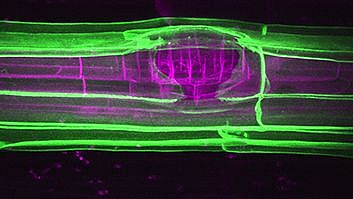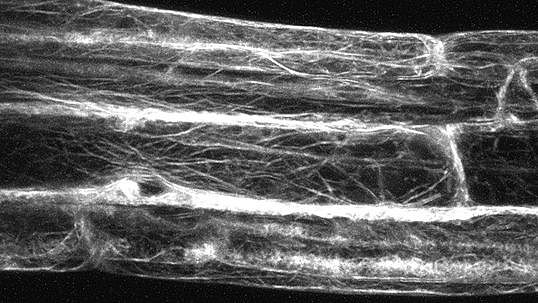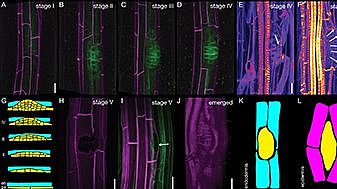Understanding spatial accommodating responses during plant development
Plant Cell Biology
Osmotically-driven turgor pressure of plant cells can be higher than that of a car tire. It puts tremendous forces onto cell walls and drives changes in cell shape. This has given rise to unique mechanisms to control organ formation in comparison to metazoans. The fascinating interplay between forces and local cellular reorganization is poorly understood. Growth of lateral roots is a prominent example of a developmental process in which mechanical forces between neighboring cells are generated. Lateral roots grow from a single cell layer that resides deep within the primary root. On its way out, lateral roots grow through the overlying endodermal, cortical and epidermal cell layers. We recently demonstrated that endodermal cells actively accommodate lateral root formation. Responses include a dramatic volume loss and a controlled degradation of their lignin-based paracellular diffusion barrier. The lateral root system provides a unique opportunity to elucidate the molecular and cellular mechanisms how mechanical forces and intercellular communication regulate spatial accommodation during plant development.
Research topics
- Lateral root development
- Cell volume regulation
- Mechanosensing
- Development
- Cell biology
Recent Publications
► Google Scholar: https://scholar.google.ch/citations?hl=de&user=_cNNy7MAAAAJ
- Bacterial gas-lighting of lateral root formation
T Grube Andersen, JEM Vermeer
Proceedings of the National Academy of Sciences 120 (17), doi: e2303919120 2023 - Microtubule-based perception of mechanical conflicts controls plant organ morphogenesis
D Stöckle, BJ Reyes-Hernandez, A Vilches Barro, M Nenadic, Z Winter, ...
Science Advances 8, 1-11, 10.1126/sciadv.abm4974 2022 - GDSL-domain proteins have key roles in suberin polymerization and degradation
Ursache, Robertas; Teixeira, Cristovao De Jesus Vieira; Tendon, Valerie Denervaud; Gully, Kay; De Bellis, Damien; Schmid-Siegert, Emanuel; Andersen, Tonni Grube; Shekhar, Vinay; Calderon, Sandra; Pradervand, Sylvain; Nawrath, Christiane; Geldner, Niko; Vermeer, Joop E. M
Nature Plants 10.1038/s41477-021-00862-9 Published: MAR 2021 - Pluripotent Pericycle Cells Trigger Different Growth Outputs by Integrating Developmental Cues into Distinct Regulatory Modules
Xiao, Wei; Molina, David; Wunderling, Anna; Ripper, Dagmar; Vermeer, Joop E. M.; et al.
Current Biology 10.1016/j.cub.2020.08.053 NOV 16 2020 - Plant Biology: Journey to the Center of the Casparian Strip
Stockle, Dorothee; Vermeer, Joop E. M.
Current Biology 10.1016/j.cub.2020.08.041 OCT 19 2020 - Translating Ribosome Affinity Purification (TRAP) to Investigate Arabidopsis thaliana Root Development at a Cell Type-Specific Scale
Thellmann, Martha; Andersen, Tonni Grube; Vermeer, Joop E. M.
Jove-journal Of Visualized Experiments 10.3791/60919 MAY 2020 - Geometric cues forecast the switch from two- to three-dimensional growth in Physcomitrella patens
Tang, Han; Duijts, Kilian; Bezanilla, Magdalena; Scheres, Ben; Vermeer, Joop E. M.; et al.
New Phytologist DOI: 10.1111/nph.16276, MAR 2020 - Cytoskeleton Dynamics Are Necessary for Early Events of Lateral Root Initiation in Arabidopsis
Barro, AV; Stockle, D; Thellmann, M; Ruiz-Duarte, P; Bald, L; Louveaux, M; von Bom, P; Denninger, P; Goh, T; Fukaki, H; Vermeer, JEM; Maizel, A
CURRENT BIOLOGY, 29 (15):2443-+; 10.1016/j.cub.2019.06.039 AUG 5 2019 - The role of plant root systems in evolutionary adaptation
Shekhar, V; Stockle, D; Thellmann, M; Vermeer, JEM
Edited by: Grossniklaus U
PLANT DEVELOPMENT AND EVOLUTION, 131 55-+; 10.1016/bs.ctdb.2018.11.011 2019 - …

Prof. Dr. Joop Vermeer
University of Neuchâtel
Institute of Biology
2000 Neuchâtel
Phone: +41 32 718 2100
Interdisciplinary
- Arabidopsis functional genomics
- Live cell imaging
- Computational morphodynamics
- Greengate cloning



